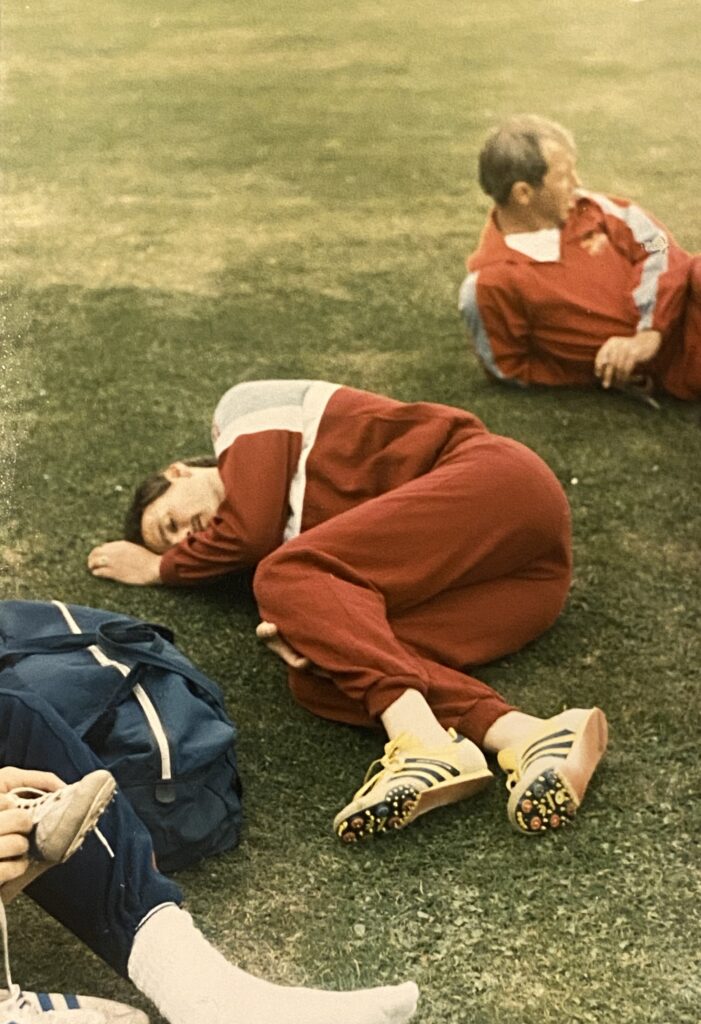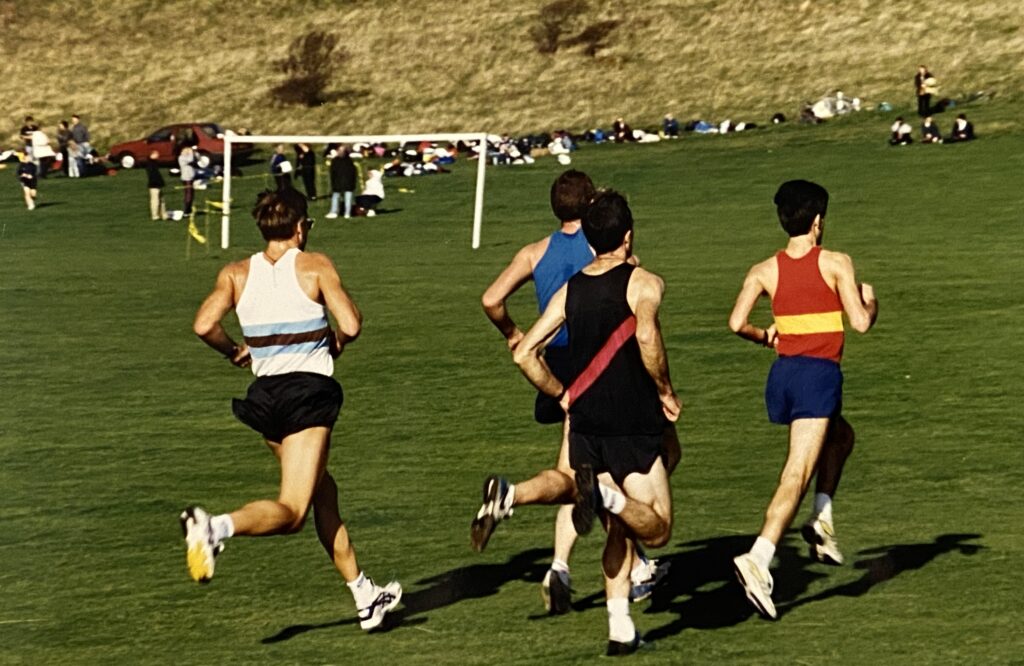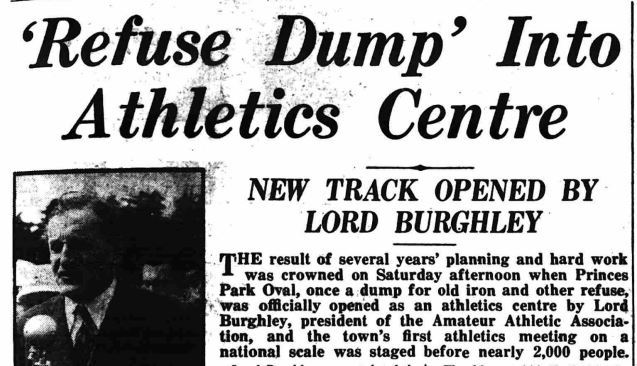1894
Eastbourne Rovers were formed in 1894 as an offshoot of the Eastbourne Bicycle Club founded in 1877. Initially, Rovers were just a cycling club with the full name Eastbourne Rovers Cycle Club. In the same year an Eastbourne Athletic Club was also founded. Eastbourne AC had dwindled by 1896, around the same time the Rovers added a “Harriers” section. Many of the members of Eastbourne AC had moved to the new Rovers section. The club was known as Eastbourne Rovers Cycling and Athletic Club from around 1896.

Early years
The first president of the club was Mr Alderman William Epps Morrison (3 times mayor), who died in 1895 just a year after the club formed.
Mr Alderman Walter Henry Burt took over as president, and features in many news stories of the day. Burt, a solicitor, was a keen pursuer of the outdoor sports, and by all accounts did much to enhance the club’s status and attract members in its early years, and surely set the basis for the two strong Rovers clubs that exist today.
In 1905, the final run of the Harriers section is documented, and Eastbourne Athletic Club is formed once again, taking virtually the entire Harriers section of Rovers. However, it was harmonious, as you will read later at various points in the club’s history it was considered better to separate cycling from athletics. Eastbourne Athletic Club’s HQ would be at the Terminus Hotel.
Both clubs held meetings, often at Devonshire Park including both athletics and cycling events. It is not clear when Eastbourne Athletic Club ceased, due to the name being used many times by different incarnations of the club. Various stories show breakaway members back with Rovers by the early 1920’s. A newspaper appeal for Eastbourne Athletic Club members was made in 1928, though this time the club would be diluted to include football, cricket amongst other athletic sports. [Further research still takes place!]

Colours
We believe Eastbourne Rovers’ athletics kit has always been blue hoops with a brown hoop in the middle. Various vest suppliers over the years has seen the middle hoop transition unintentionally to the maroon colour we have today. We do not know why we have these colours except that they have to be different to other Sussex clubs. A reference to the club colours was made in the 1898 Eastbourne Gazette as a bouquet in club-coloured chocolate and blue ribbons was presented at the end of the annual Devonshire Park sports meeting. The Eastbourne Athletic Club from 1894-1896 wore blue and gold, it is not known what the 1905 Eastbourne Athletic Club wore.

Early meetings
Talking of the annual meeting, the first Devonshire Park meeting hosted by Eastbourne Rovers C&AC was held on Whit Monday 1896. Events listed at the meet included 120 yards, 440 yards, and a mile race, amongst cycling races and the fun but very skilful “Tilting at the Bucket”. Games at Devonshire Park had taken place as early as 1875 though it is not clear who hosted them.
Rovers early “headquarters” is frequently referenced as being The Royal Hotel, Terminus Road – on the site now occupied by NatWest bank. A number of road races were organised by Eastbourne Rovers to start or finish at the hotel, including a 26-mile race from Brighton to Eastbourne via Lewes in 1903. 14 started the race but only 7 completed it. The winner came home in 2:57:08! The Royal Hotel hosted awards galas and the AGM too. Many runs, rides and meetings had a Smoking Concert, or “Smoker” in the evening!



Between the wars
The athletics side of the club dwindled, and it didn’t go unnoticed by the mayor of the town, who expressed his sadness at the club’s annual dinner in 1937. But to the delight of the room, plans were afoot for the section’s revival in spring.
In March 1939, Eastbourne Rovers revived their annual Whit Monday meeting, holding it at Ascham St. Vincents school, Carlisle Road. The event was said to be popular amongst athletes and spectators with 20 disciplines on offer. However, the onset of war made this a one off. [Further research still takes place!]
A club reformed
The club was reformed in August 1946, a general meeting was held at The Gildredge Hotel, on the site now occupied by Costa Coffee on the corner of the Beacon opposite the station. Mr K Creasey was appointed to look after athletic operations. However, whilst the cycling section was shortly thriving, the athletic members were writing to the local press a year later to complain about the lack of facilities for athletics.
A push for athletics
By 1948 the complaints were heard and Eastbourne Rovers along with the Council Entertainments Committee were surveying Princes Park as a venue for a track. At the same time another push was made to properly revive the athletic section. A combined meeting was held at the Prince’s Park cricket ground later that year, with the mayor recognising the need for better facilities. These meetings continued with up to 3 a year.
Steady hands ensure survival and revival

By 1950, the club could boast 140 members. Mr William Ranger had secured use of St Cyprians school field for athletic training. The club was considered reformed and was competing again, and plans for The Oval were firmly afoot.
At the 1951 AGM, it was decided that the cycling and athletic clubs would have separate committees. Total membership was 152 with 74 athletes.
The first meeting on the new cinder track known as The Oval was on 6 June 1952 when Eastbourne staged a match against Brighton AC. Cycling still featured on a grass track inside the cinder track.
The Oval was officially opened on 25 July 1953 by Lord Burghley, the president of the Amateur Athletics Association. The AAA sent a strong team to compete against a combined Kent and Sussex team, with the AAA winning 110 points to 60. The match was watched by 2000 spectators. Much credit goes to William (Bill) Ranger and Doug Long (our current president’s father) for reviving the club in the early 50s. William Ranger received an MBE in 1956.
Meetings at The Oval
The club used to hold and attend several inter-club trophy meetings throughout the season. One of these was the McCaffery Trophy (named after a talented discus thrower at our club who tragically died in a motor bike accident at a young age.) We competed against Crawley, Brighton, Hastings and East Grinstead. But with so many other open meetings starting up and the fact we did not have a synthetic track they were eventually phased out.
Notable athletes

Much research is still to take place on the athletes themselves. Though whilst doing broader research of the club, some names are persistent.
George Siggs was a prominent runner in the 1900s. He showed great depth by coming third in the clubs Brighton to Eastbourne marathon, but also winning in the mile, 880 yards and cross countries! He is related to one of our current endurance runners too.
Pat Ranger, one of William’s sons was an international distance runner for Rovers in the 1950’s, often competing at the White City Games in the 3-mile. Don Ranger preferred football, playing for Eastbourne Town, was described as a useful sprinter. Both were members of the club.
Splitting up?
The 1953 AGM lasted over 4 hours and resulted in a number of rule changes as it was approved that the cycling and athletics sections would now manage their own finances. By the mid 50s, talk of the cycling and athletic section formally splitting into two clubs surfaced. The sections now having their own committees and separate finances, the two sections were said to have very little in common. The club remained as Eastbourne Rovers Cycling and Athletic club for a few more years.
The club finally and formally split at a special general meeting held 5 May 1971, citing administrative reasons. The two clubs would now be formally known as Eastbourne Rovers Athletic Club and Eastbourne Rovers Cycling Club, though this had been the case informally for some time.
There was even said to be a small break off group from Eastbourne Rovers AC who called themselves Eastbourne Gold Star after one of the founders. They later re-joined our club and donated a trophy. [Further research still takes place on Gold Star!]
Trophies
A number of trophies are given at our annual awards, many bear the names of members. All our trophies have been donated by past club members and / or relatives.
- Jim Lindsay – Past chairman who died early from Cancer
- Don Ranger – A former president of the club and athlete who was tragically killed in train accident
- Carol Russell – A physio and athlete who was co-founder of ‘Sportswise’ who died early from cancer
- Don Star – a founder member of gold star
- Jessie Jones – Was a race walker official and she donated the trophy for girls’ cross country
Modern history

Most history articles neglect their recent history, making it really hard to research in just a few years’ time. We will try to include notable events without turning this page into a news feed!
Rovers had to wait nearly fifty years before they got use of an all-weather track. In 2000, we moved to our current home at Eastbourne Sports Park.
The club has always had a road running section. By the mid 2010s, the Road Runners groups began to thrive and grow again, under the leadership of Russell and Zoe Gardham, and particularly after the 2012 Olympic boom and the dawn of parkrun in Eastbourne. Eastbourne parkrun was started by Eastbourne Rovers own Stuart Pelling, with help from other Rovers and Hailsham Harriers members.
During 2021 the club lost use the indoor facilities at the Sports Park as the club room, kitchen and equipment storage areas were converted into a gym. In 2022 Rovers purchased their own cabin to use as a club room. This was funded by the club’s savings and a generous sponsor. It now forms a hub where we can meet, put up notices, hold committee meetings and be a base for our club. It opened on 1st February 2022.
2022 saw the club run its first Couch to 5k programme, ensuring the Eastbourne public have a fun, friendly and accessible route into the sport.


Eastbourne Rovers compete in the Southern Athletics league, and recently have twice been in Division 1. 2022 in many ways was a year of rebuilding after the pandemic. Athletes relished the opportunity to compete in Division 1, but many athletes who helped gain promotion in 2019 were no longer with the club. There were many good performances, but Rovers were due to be relegated at the end of the season. However, a restructure of the SAL meant Rovers will stay in Division 1 for the 2023 season.
2022 also saw the Sussex Masters League return. The track and field meets are commonly referred to as the Vets League. Eastbourne Rovers had combined with Hailsham Harriers for a number of years but decided to go it alone to encourage its own members to participate. The decision proved to be a success and spiked new interest in not only track and field participation but officiating and volunteering too, after a successful home match.
At the time of writing, in October 2022 the club had in excess of 260 members.
Life members
The club has a number of notable life members.
- Janis Long – Janis has been at the club since 1954 and as well as being a very talented athlete has been secretary, fixture secretary, team manager, coach and for many years she has run all our home meetings. Her father is credited for reforming the club.
- Liz Brandon – Liz has competed for the club, been a team manager of the girls’ teams and masters, a throws coach and is one of our qualified officials. Liz also makes sure our home meetings run smoothly.
- Brian Slaughter – Brian joined the club at an early age and has competed ever since. He has team manged the men’s team and masters. Brian has also held many positions on the committee over the years, has coached many disciplines and is one of our qualified officials.
- Sue Keen – Sue joined the club when she came to study here at Chelsea PE College. Sue started coaching others in 1975 and continues to do so. She has held most positions on the committee including chairman 3 times. Sue manages the women’s team and young athletes’ leagues, organised open meetings and generally works hard behind the scenes for the club.
- Stuart Pelling – Stuart became a member of Rovers at the age of 13, and since then he has been a remarkable sprinter, competing in all league matches and Sussex competitions. Over the years, he has served as the team manager for the Senior Men’s team and continued this role when the team joined the Women’s team for the SAL league. In addition to his contributions on the track, Stuart is a qualified ‘starter’ and has officiated in many capacities at local matches. He is also a skilled coach with a keen interest in middle distance running and high jump.
- Mike Thompson – Mike first joined Rovers in the 1980s. After a brief hiatus, he returned to become an integral part of our community. Mike is a dedicated athlete, coach, and official for the club. He has held the position of chairman and played a vital role in uniting the track and road running sections. Mike has also been instrumental in developing our club’s facilities. His efforts have led to the establishment of our porta cabin clubroom and new amenities at the track, and he continues to work tirelessly behind the scenes to improve our club.
We are still researching this piece and hope to fill in any gaps soon.












Sources/Researchers:
British Newspaper Archive
Eastbourne Herald
Eastbourne Gazette
Eastbourne Chronicle
Sussex Agricultural Express
Sporting Life
Sussex Athletics
Janis Long – ERAC
Angela Morgan – ERAC
Sue Keen – ERAC
Jane Lade – ERCC
Richard Davis – ERAC



